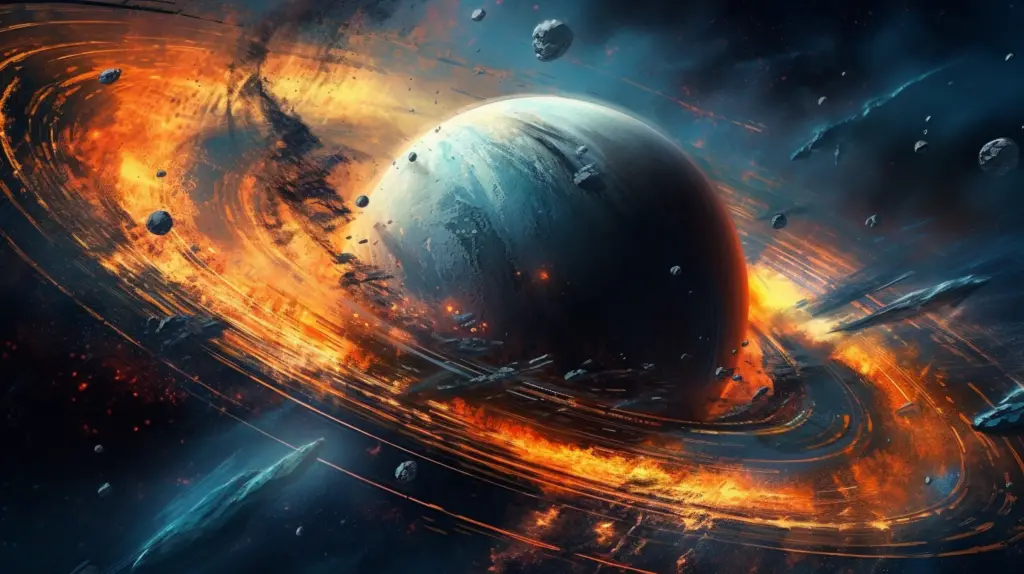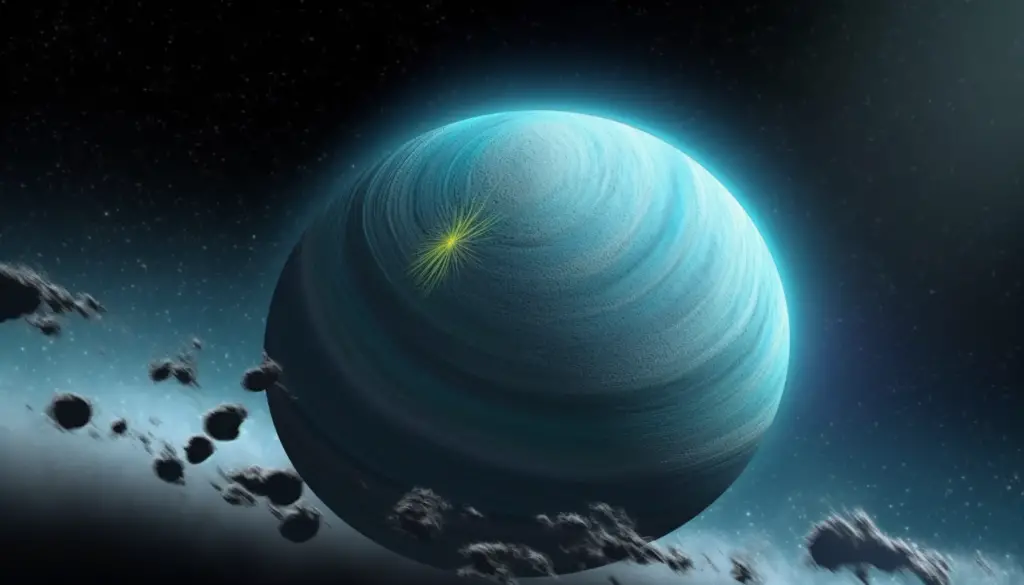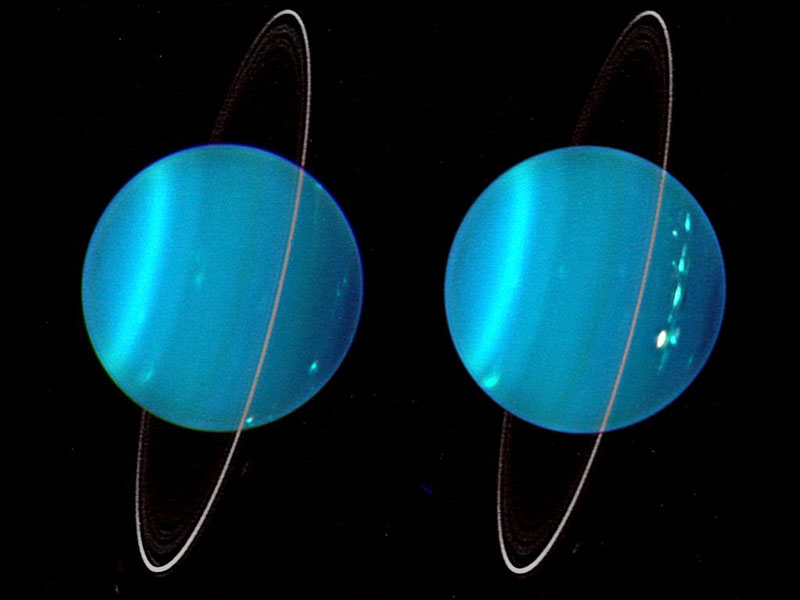New research reveals that Uranus takes a pounding more frequently than previously thought. Two giant collisions turned Uranus on its side, unraveling the mysteries of its axial tilt and shedding light on planetary evolution.
Table of Contents

Introduction
The mysteries of our solar system continue to unfold, and one enigma that has long intrigued scientists is the peculiar tilt of Uranus. Recent research suggests that Uranus takes a pounding more frequently than previously believed, as two colossal collisions during its early formation played a crucial role in tilting the planet on its side. This groundbreaking discovery sheds light on the turbulent past of Uranus and deepens our understanding of planetary evolution. In this article, we will delve into the fascinating details of these cosmic collisions and their effects on Uranus.
Watch it as a video instead of reading:
Uranus Takes a Pounding More Frequently: Unraveling the Mystery
For decades, astronomers have been captivated by the unusual axial tilt of Uranus. Unlike most planets that rotate on an axis perpendicular to their orbital plane, Uranus spins nearly on its side. The question of what caused this severe tilt has perplexed scientists, but a recent study published in the scientific journal “Nature Astronomy” has provided some compelling answers and revealead that Uranus takes a pounding more frequently.
Astronomer Have Discovered A Mysterious Object, Which Is 570 Billion Times Brighter Than The Sun
The Gaia hypothesis: Earth has its own life and we are part of a super organism

The Impact of Two Giant Collisions
According to the study, Uranus experienced not one, but two massive collisions during its formative years. These colossal impacts occurred when the planet was still in the process of accreting material from the protoplanetary disk that surrounded our young Sun. The first collision involved a body approximately twice the size of Earth, while the second involved a smaller object, roughly the size of our moon.
The Violent Cosmic Dance
The effects of these cataclysmic events were truly transformative. As the two colliding bodies approached Uranus, they unleashed an enormous amount of energy upon impact. The intense gravitational forces caused the planet to tilt dramatically, turning it on its side. These collisions not only altered Uranus’s axial tilt but also had profound consequences for its internal structure and overall evolution.

Unveiling Uranus’s Composition
One of the unexpected outcomes of these collisions is the revelation of Uranus’s internal composition. Scientists believe that the intense impacts may have disrupted the planet’s outer layers, causing a portion of its gaseous envelope to be stripped away. This suggests that Uranus has a smaller gaseous envelope compared to other gas giants like Jupiter and Saturn, and it may have a more substantial rocky core.
A Window into Planetary Dynamics
The discovery of the two giant collisions on Uranus provides a unique opportunity for scientists to study the dynamics of planetary formation and evolution. By analyzing the aftermath of these cosmic encounters, researchers can gain insights into the early stages of our solar system’s history. The findings not only deepen our understanding of Uranus but also have implications for the formation of other planets within and beyond our own solar neighborhood. The revelation that Uranus takes a pounding more frequently has also made news.
Unraveling the Mysteries of Axial Tilt
The axial tilt of Uranus has long been a puzzle. Prior to this study, scientists had proposed various hypotheses to explain the planet’s extreme tilt, including gravitational interactions with other celestial bodies. However, the discovery of the two giant collisions provides a more compelling explanation for Uranus’s unique orientation. It highlights the significance of violent impacts during the early stages of planet formation.
The Role of Computer Simulations
To reconstruct the events leading to Uranus’s axial tilt, scientists used advanced computer simulations. These simulations allow researchers to model the dynamics of planetary collisions and accurately reproduce the consequences of such violent encounters. By fine-tuning the parameters of the simulations, scientists were able to determine the most plausible scenarios that led to Uranus’s peculiar tilt.
Implications for Exoplanet Research
The study of Uranus’s axial tilt has implications beyond our own solar system. With the growing number of exoplanet discoveries, scientists are eager to understand the diversity of planetary systems throughout the universe. The findings regarding Uranus’s tilt and the role of giant collisions offer valuable insights into the formation and evolution of exoplanets.
By studying the effects of cosmic impacts on Uranus, researchers can develop a better understanding of the factors that influence the orientation of exoplanets and also why Uranus takes a pounding more frequently. This knowledge is crucial for interpreting the data obtained from exoplanet observations and determining the likelihood of finding similar tilted planets in other star systems.
Implications for Exoplanet Research
The discovery that Uranus takes a pounding more frequently opens up new avenues for further research and exploration. Scientists are now motivated to investigate other planetary systems, both within and beyond our solar system, to search for similar evidence of past collisions and tilted planets. This knowledge will contribute to our understanding of planetary dynamics and the broader processes that shape the universe.
Furthermore, this groundbreaking research could inspire future space missions to study Uranus up close. The study of Uranus’s unique tilt and its consequences can provide crucial data for designing missions to explore the planet’s atmosphere, its internal structure, and its moons. By gathering more information about Uranus, scientists can continue to refine their understanding of the planet’s formation and further validate the theories surrounding its axial tilt.
Conclusion
The recent study revealing that Uranus takes a pounding more frequently than previously believed has provided a compelling explanation for the planet’s extreme axial tilt. The two giant collisions during its early formation not only turned Uranus on its side but also had far-reaching effects on its composition and evolutionary trajectory. This groundbreaking discovery not only deepens our understanding of Uranus but also offers valuable insights into the dynamics of planetary formation and the diversity of planetary systems beyond our own.
As scientists continue to unravel the mysteries of our solar system and explore the vastness of space, the study of Uranus and its unusual tilt will undoubtedly contribute to our knowledge of planetary dynamics, exoplanet research, and the broader processes that shape our universe. Through advanced computer simulations and future space missions, we will continue to unlock the secrets of Uranus, revealing the fascinating story of its cosmic collisions and the remarkable journey that led to its current state.
Reference(s):

